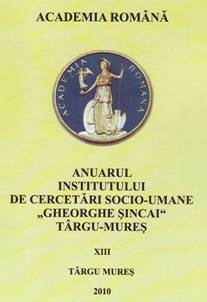Între „papistaşi” şi „rusolatri”. Repere ale imaginii clerului românesc reflectate în corespondenţa lui George Bariţiu
Living between “Papists” and “Pro-Russians”: Perspectives on the Image of the Romanian Ecclesiastical Élite Reflected in the Correspondence of George
Author(s): Carmen Maria DorlanSubject(s): Cultural Essay, Political Essay, Societal Essay
Published by: Institutul de Cercetări Socio-Umane Gheorghe Şincai al Academiei Române
Keywords: correspondence; George Bariţiu; ecclesiastical élite; social representation; journalism
Summary/Abstract: The evolution of the Romanian journalism in Transylvania during the first period of its existence has been based, as far as the Romanian historical contributions are concerned, on a theoretical and methodological thinking subordinated to the multiple meanings and utilities of the interpretive categories identity and communication. As a result, their interest has been focused on the role of the multicultural context in order to favor, give significance and identify the press and its representatives, permanently corroborating the process to the politics promoted by the Habsburg monarchy regarding the national identity construction. Previous historical writing focused on the significance of the Romanian press as a result of its interests related to the élite contribution to this evolution. It also reflected the specific conditions in which the Romanian journalism developed at the middle of the 19th century and the multiple implications of a society mainly agrarian that offered few opportunities to favor capital or industrial development or even to spread the practice of reading. Instead this society offered the possibility of re-evaluating the career options in the intellectual media, in many cases preferring journalism, teaching or law to priesthood, as a reflection of a larger social background and different possibilities for employment. Rethinking about the content of the extended correspondence maintained by George Bariţiu with the intellectual media of his time from the perspective of the recent methodological and interpretive contributions regarding the identity or the modern Romanian society’s social, cultural, and confessional representations proves to be a useful and necessary intent if we take into consideration the fact that many of the aspects referring to the distribution and the receptivity of the journalistic activity during the decades at the middle of the 19th century are still unknown. Included among autobiographical sources, the correspondence may be considered as well an instrument used in order to display discursive practices elaborated by social groups or representative individuals. It also reveals the authors’ effort of sustained performance through which they formulate and modify their own experience in order to build their identity and power. Likewise, it reflects the dimension of the Romanian clergy’s contribution to the impact of the journalism on the society in Transylvania, analyzed here for the period previous to the moment 1848, and on the social typologies operated within the Romanian intellectual media. This way the practice of correspondence improves our perception of the way the press inter-relates with the process of élite and nation formation and reflects also the interdependence existing between the movement for national liberation, the competition between various élite groups and their opportunities to use their own resources of power. Based on this type of historical source the article intends to reflect on th
Journal: Anuarul Institutului de Cercetări Socio-Umane »Gheorghe Şincai« al Academiei Române
- Issue Year: 2010
- Issue No: 13
- Page Range: 150-164
- Page Count: 15
- Language: Romanian

